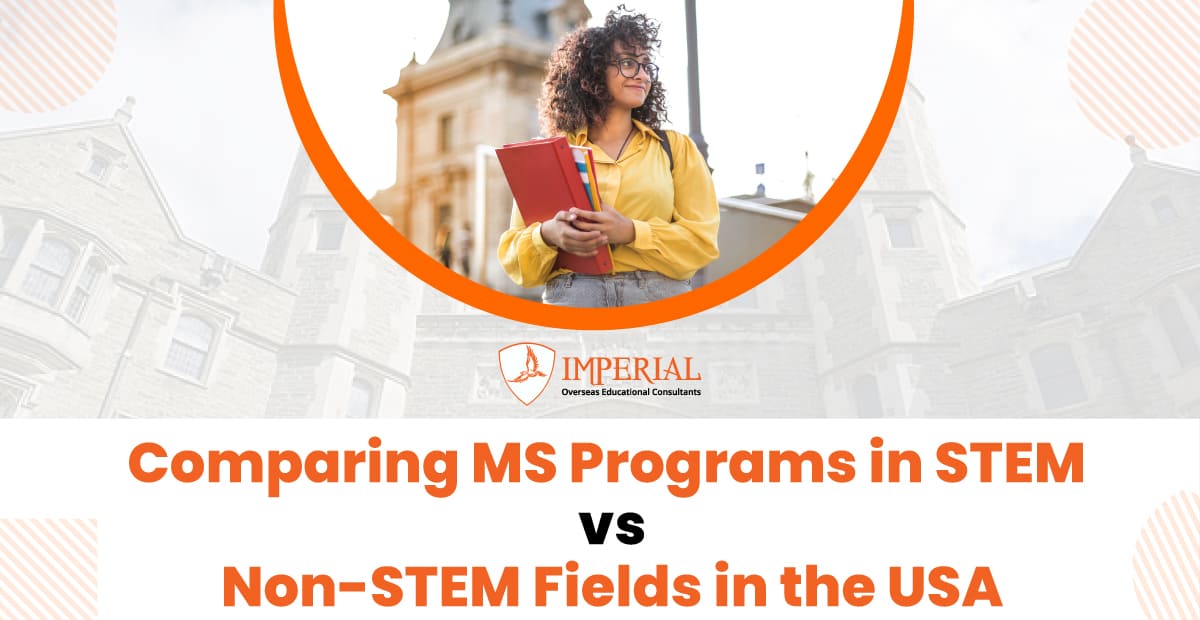
Comparing MS Programs in STEM vs. Non-STEM Fields in the USA
The MS program in USA opens doors to a multitude of opportunities for career ventures to students. In determining what to choose between the STEM and the Non-STEM fields, one needs to remember the factors that include job opportunities, earning potential, and passion for a specific domain. This blog compares both the paths and helps outline important considerations for making the great decision in choosing your Master’s journey in USA.
STEM vs. Non-STEM: Understanding the Core Differences
The most notable difference between STEM and non-STEM courses lies in focus. For example, analytical as well as technical skills are emphasized for STEM programs, such as computer science, engineering, or data science. Non-STEM programs are found to focus more on business, humanities, or social work through skills built upon communication, creativity, and problem-solving. The distinct fields will shape different professionals to specifically contribute to the economy and should be chosen according to career goals and interests.
Career Opportunities and Earning Potential
The MS program in USA has a bright scope if you are a STEM graduate but it lacks the same potential in the non STEM streams. The huge demand for specialists in various sectors such as data science, AI, healthcare, etc has created a need for STEM graduates. As stated by the U.S. Bureau of Labor Statistics, the growth of employment in STEM areas is expected to be 11% between 2021 and 2031 which is much higher compared to the average growth in all job sectors. Annual salaries for software development, data science, engineering, and related jobs are over 100,000 dollars on average. By way of example:
- Software Developers: $120,730/year
- Data Scientists: $94,280/year
- Mechanical Engineers: $88,430/year
Also, US employers in tech, finance, healthcare, and engineering jobs offer reliable employment and good pay to STEM degree holders.
STEM graduates are more reliable when it comes to finding jobs and earning good salaries in well-paying industries, for instance, tech, finance, healthcare, and engineering. Non-STEM graduates, on the other hand, generally start at lower salaries, and are likely to work in business, art, education, or media. They not only do management, marketing, public relations, and other projects as well but paves the way for cultural and social change. For example:
- Accountants: $71,500/year
- Media Managers: $62,586/year
- Teachers (Architecture): $87,900/year
Even though the middle earning bracket is lower, non-STEM fields offer plenty of opportunities to head the business. Industry sectors that are people-oriented, expressive, and socially responsible also provide quite interesting career opportunities.
The OPT Advantage for STEM Students
An especially valuable advantage of pursuing a US-based STEM MS is the ability to apply for an OPT extension for 36 months. Under an OPT, international students can get experience in their field up to three years after graduation. This puts the graduates at much more favorable grounds for employment. Non-STEM graduates usually cannot spend more than 12 months on OPT.
Balancing Analytical Skills with Creativity: Choosing the Right Path
While STEM programs focus on the future with an emphasis on technology and problem-solving, non-STEM programs may focus on essential skills, such as soft skills, creativity, and leadership. If one has always been fascinated by innovation and technical challenges, then STEM is the way to go. On the other hand, if one is attracted to management, marketing, or a cultural sector, a non-STEM MS might be a better fit for one’s aspirations. Both fields have unique avenues in which you can make your presence and impact felt in the world and economies.
Cultural and Societal Impact
Graduates of the STEM disciplines are the ones at the forefront of technological innovation for the solutions to problems of global health care, climate change, and cybersecurity. The contributions of non-STEM scholars to shaping culture, influencing public policy, and helping respond to social issues in society are just huge, but the areas differ according to what draws passion: innovation or human connection.
Conclusion
Pursuing a Master’s in the USA is a life-changing decision, and choosing between STEM and non-STEM programs depends on your career goals, skills, and interests. Whether you opt for the high demand and earning potential of STEM or the broad societal influence of non-STEM, both offer incredible opportunities for growth.
If you’re looking for personalized guidance on choosing the right MS program in the USA, Imperial Overseas Education Consultants here to help. Our experts will guide you through every step of the application process, from university selection to visa assistance. Contact us today to Book one-to-one counseling and take the first step toward your dream career.
FAQs
MIT, Stanford, and Harvard lead for STEM, while institutions like Yale and NYU excel in non-STEM fields.
While not mandatory, work experience can strengthen your application for both STEM and non-STEM programs.
Requirements typically include a relevant bachelor’s degree, GRE/GMAT scores, and proof of English proficiency through TOEFL or IELTS.
STEM careers generally offer higher starting salaries and faster growth, but non-STEM fields like business and education provide strong leadership opportunities.
Consider your interests, career goals, and the types of skills you want to develop. Analytical thinkers may prefer STEM, while creative problem-solvers might lean toward Non-STEM.



